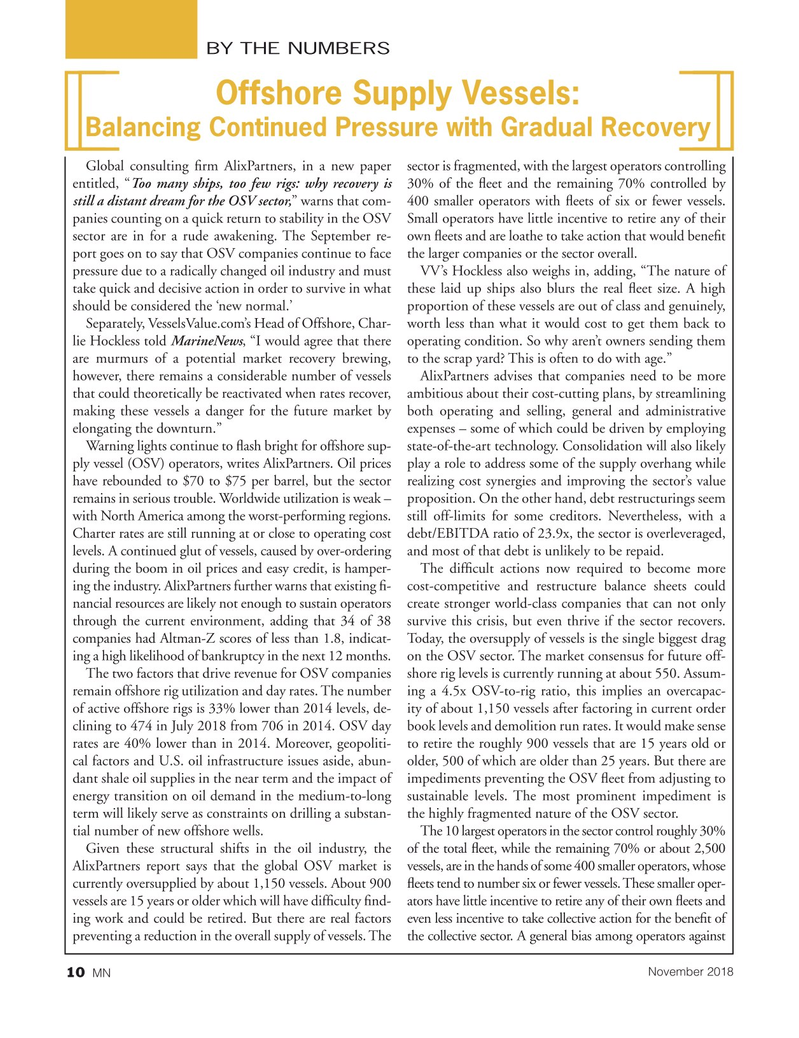
Page 10: of Marine News Magazine (November 2018)
Workboat Annual
Read this page in Pdf, Flash or Html5 edition of November 2018 Marine News Magazine
BY THE NUMBERS
Offshore Supply Vessels:
Balancing Continued Pressure with Gradual Recovery
Global consulting ? rm AlixPartners, in a new paper sector is fragmented, with the largest operators controlling entitled, “Too many ships, too few rigs: why recovery is 30% of the ? eet and the remaining 70% controlled by still a distant dream for the OSV sector,” warns that com- 400 smaller operators with ? eets of six or fewer vessels. panies counting on a quick return to stability in the OSV Small operators have little incentive to retire any of their sector are in for a rude awakening. The September re- own ? eets and are loathe to take action that would bene? t port goes on to say that OSV companies continue to face the larger companies or the sector overall.
pressure due to a radically changed oil industry and must VV’s Hockless also weighs in, adding, “The nature of take quick and decisive action in order to survive in what these laid up ships also blurs the real ? eet size. A high should be considered the ‘new normal.’ proportion of these vessels are out of class and genuinely,
Separately, VesselsValue.com’s Head of Offshore, Char- worth less than what it would cost to get them back to lie Hockless told MarineNews, “I would agree that there operating condition. So why aren’t owners sending them are murmurs of a potential market recovery brewing, to the scrap yard? This is often to do with age.” however, there remains a considerable number of vessels AlixPartners advises that companies need to be more that could theoretically be reactivated when rates recover, ambitious about their cost-cutting plans, by streamlining making these vessels a danger for the future market by both operating and selling, general and administrative elongating the downturn.” expenses – some of which could be driven by employing
Warning lights continue to ? ash bright for offshore sup- state-of-the-art technology. Consolidation will also likely ply vessel (OSV) operators, writes AlixPartners. Oil prices play a role to address some of the supply overhang while have rebounded to $70 to $75 per barrel, but the sector realizing cost synergies and improving the sector’s value remains in serious trouble. Worldwide utilization is weak – proposition. On the other hand, debt restructurings seem with North America among the worst-performing regions. still off-limits for some creditors. Nevertheless, with a
Charter rates are still running at or close to operating cost debt/EBITDA ratio of 23.9x, the sector is overleveraged, levels. A continued glut of vessels, caused by over-ordering and most of that debt is unlikely to be repaid.
during the boom in oil prices and easy credit, is hamper- The dif? cult actions now required to become more ing the industry. AlixPartners further warns that existing ? - cost-competitive and restructure balance sheets could nancial resources are likely not enough to sustain operators create stronger world-class companies that can not only through the current environment, adding that 34 of 38 survive this crisis, but even thrive if the sector recovers. companies had Altman-Z scores of less than 1.8, indicat- Today, the oversupply of vessels is the single biggest drag ing a high likelihood of bankruptcy in the next 12 months. on the OSV sector. The market consensus for future off-
The two factors that drive revenue for OSV companies shore rig levels is currently running at about 550. Assum- remain offshore rig utilization and day rates. The number ing a 4.5x OSV-to-rig ratio, this implies an overcapac- of active offshore rigs is 33% lower than 2014 levels, de- ity of about 1,150 vessels after factoring in current order clining to 474 in July 2018 from 706 in 2014. OSV day book levels and demolition run rates. It would make sense rates are 40% lower than in 2014. Moreover, geopoliti- to retire the roughly 900 vessels that are 15 years old or cal factors and U.S. oil infrastructure issues aside, abun- older, 500 of which are older than 25 years. But there are dant shale oil supplies in the near term and the impact of impediments preventing the OSV ? eet from adjusting to energy transition on oil demand in the medium-to-long sustainable levels. The most prominent impediment is term will likely serve as constraints on drilling a substan- the highly fragmented nature of the OSV sector.
tial number of new offshore wells. The 10 largest operators in the sector control roughly 30%
Given these structural shifts in the oil industry, the of the total ? eet, while the remaining 70% or about 2,500
AlixPartners report says that the global OSV market is vessels, are in the hands of some 400 smaller operators, whose currently oversupplied by about 1,150 vessels. About 900 ? eets tend to number six or fewer vessels. These smaller oper- vessels are 15 years or older which will have dif? culty ? nd- ators have little incentive to retire any of their own ? eets and ing work and could be retired. But there are real factors even less incentive to take collective action for the bene? t of preventing a reduction in the overall supply of vessels. The the collective sector. A general bias among operators against
November 2018
MN 10
MN Nov18 Layout 1-17.indd 10 MN Nov18 Layout 1-17.indd 10 10/23/2018 11:35:08 AM10/23/2018 11:35:08 AM

 9
9

 11
11
